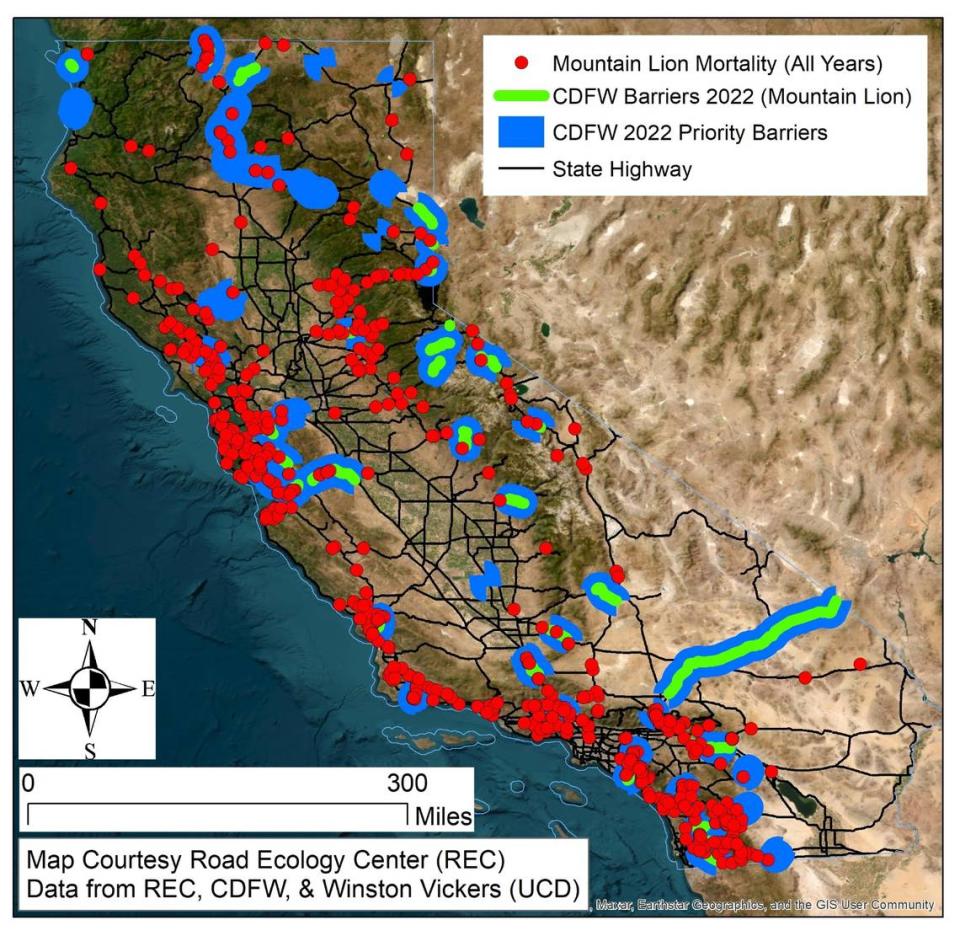Dozens of mountain lions die on California roads every year. Here are the hot spots
As the recent deaths of the beloved P-22 and another mountain lion in Southern California demonstrated, Golden State roadways are an often fatal obstacle for cougars.
Vehicle collisions have killed, on average, about 70 mountain lions a year on California state highways since 2015, according to a report released this week by the UC Davis Road Ecology Center.
The true total killed by vehicles is almost certainly higher, researchers wrote, because the report does not include cougars killed on city or county roadways.
Many of the most dangerous stretches of highway are found in the Bay Area and Southern California, the report found. “Particularly problematic highways” for the animals included Interstate 280 south of San Francisco, Interstate 15 in Riverside County, Interstate 5 in Siskiyou County and Highway 74 near the Santa Ana Mountains.
Researchers have also recorded dozens of mountain lion deaths on mountain highways in the Sierra Nevada foothills east of Sacramento.
The rate of roadway deaths has gradually declined by about 10% between 2015 and 2022, the report found – but that may be in large part because of the interrelated drop in California’s mountain lion population.
The decline “suggests populations may be gradually declining as rates of roadkill match population trends,” researchers wrote.
The last population study on mountain lions, completed by the California Department of Fish and Wildlife in 1996, estimated there are between 4,000 and 6,000 living in the state. An updated population estimate has been ongoing since 2014, according to state wildlife officials.
“Busy freeways also cut off mountain lions from potential mates, severely decreasing their genetic diversity and threatening their existence,” Winston Vickers, a UC Davis School of Veterinary Medicine wildlife veterinarian, said in a university news release accompanying the study.
The 2023 edition of an annual report by UC Davis wildlife researchers on roadkill incidents – or “wildlife-vehicle conflict” – centered on vehicle collisions with mountain lions.
The report concluded that crashes involving vehicles and large wildlife are an expensive affair: the incidents cost roughly $200 million a year between 2016 and 2020, and that estimate could be doubled when including crashes with deer that go unreported to law enforcement.
The financial toll comes atop grave concerns of ecological damage. Wildlife-vehicle collisions can “cause ripple effects into surrounding ecosystems up and down the food chain,” UC Davis researchers wrote in the report.
The California Department of Fish and Wildlife has identified numerous mountain lion movement barriers throughout the state, which are noted on the UC Davis researchers’ map.

A high-profile solution to the mountain lion mortality problem is the construction of wildlife crossings in the form of overpasses. One such project, the Wallis-Annenberg Wildlife Crossing, broke ground in April and will span Highway 101 in Agoura Hills. When complete, it will be one of the largest wildlife crossings in the U.S.
According to the report, California also has about 1,275 miles of highway segments with high rates of wildlife mortality that would cost a total of about $255 million to fence off – but this effort would “pay for itself” within about 10 years by reducing crashes.
Other solutions include roadway planning that avoids new construction in areas that will create new barriers for mountain lions and reducing speed limits on stretches of highway with high concentrations of wildlife, researchers wrote.
UC Davis researchers make use of data that is shared voluntarily through the California Roadkill Observation System, a website that allows drivers to anonymously upload photos of roadkill.
The report makes note of the passage of Senate Bill 1 in 2017, which allocates more than $5 billion per year for improvements to California’s transportation infrastructure, as well as the federal bipartisan infrastructure law signed by President Joe Biden in November 2021.
“There are myriad excuses for why ‘nothing can be done,’” UC Davis researchers wrote of roadway mountain lion deaths. “Lack of funding is not one of them.”

 Yahoo Movies
Yahoo Movies 
